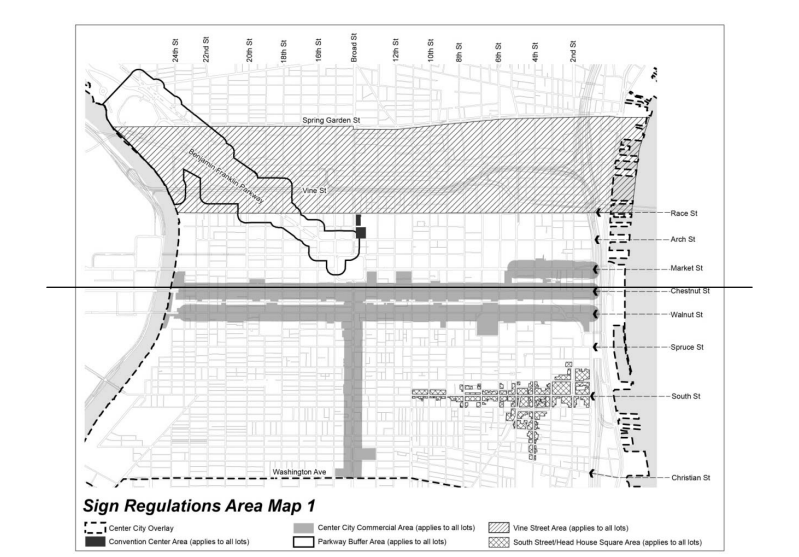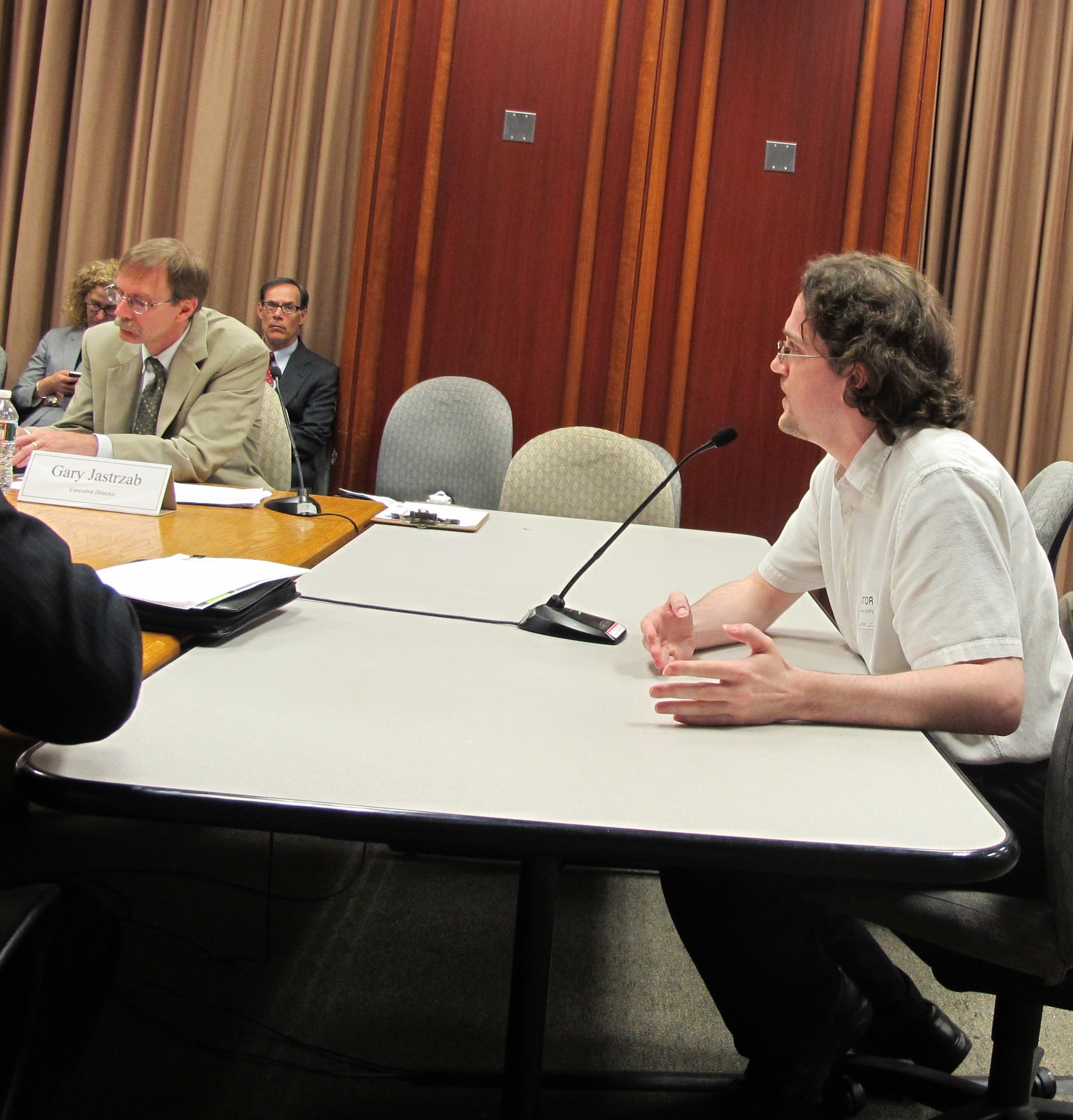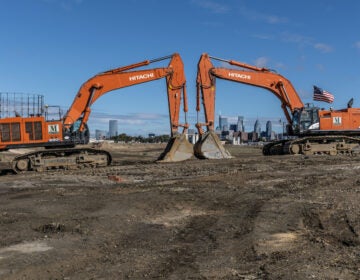Planning Commission recommends new sign controls, amendments to zoning code
The Planning Commission voted to recommend the passage of two zoning bills under consideration by City Council in a special meeting Tuesday afternoon. The bills, which were introduced into Council on May 17th, propose dozens of “clean-up amendments” to the new zoning code and an entirely new chapter on sign regulations.
The first bill, related to the clean-up amendments, will be subject to a Rules Committee hearing in Council on June 12, at 10 a.m. The sign control legislation does not yet have a committee hearing scheduled.
The clean-up amendments include hundreds of typographical and grammatical fixes, most of which were suggested by the City’s Law Department, according to PCPC’s deputy director Eva Gladstein in her presentation to the Commission. But the bill also includes a number of more substantial amendments.
Among them are provisions which:
- Restrict the ability to seek code interpretations from L&I to the “equitable owner” of a property in question, or another City agency
- Require that the Zoning Board of Adjustment provide its findings in writing for decisions on Special Exceptions as well as Variances
- Define “Bed and Breakfasts,” even though those uses are permitted in no zoning districts in the text of the new code passed by Council late last year. Gladstein said that the provision provides for Bed and Breakfasts as a “latent” use which can give Councilmembers guidance should they want to map such uses into specific areas.
- Allow for family daycare uses only in single- and two-family residences
- Change the default “contextual setback” for row house districts to zero feet from eight feet. Gladstein said the Commission staff pointed out that the norm in such districts is having no setback at all.
- Set the “trigger” for Civic Design Review of new Master Plans to the date at which the Master Plan ordinance is introduced in City Council
- Add a new area to the North Central Philadelphia Overlay, to conform to the extension of the Yorktown Special Controls District area passed by City Council last December
Craig Schelter of Development Workshop asked the Commission to table the clean-up bill, saying that “nine [of the amendments] are policy issues that merit more consideration.” Schelter objected particularly strongly to a modification to the purpose of Stream Buffers, a provision of the new code which Schelter objected to altogether during the zoning reform process.
The amendment expands the applicability of the Stream Buffer provision beyond merely the City’s drinking water sources to “maintain the base flow of streams; reduce erosion and sedimentation; control stormwater runoff; stabilize stream banks; and restore riparian habitats.” The Stream Buffer amendment generally requires that new development projects be set back at least 50 feet from waterways.
Schelter’s testimony seemed to irritate some members of the Commission. Brian Abernathy, in particular, accused Schelter of using the new amendment as a way to raise again an issue that was resolved (though not to Schelter’s liking) during the zoning code re-write.
“I’ve heard these complaints on a number of occasions,” Abernathy said, “and honestly, Craig—maybe it’s been a long day—you continually come up here, and I’m starting to question who [Development Workshop] actually represent[s], because at this point I can’t tell.”
Schelter said that the amendment goes beyond the “relatively simple” language of the new code as adopted by Council, and creates an “overly restrictive use of the fifty-foot setback.”
Last week, Councilman Bobby Henon introduced another bill containing amendments to the new code, one of which would delay the applicability of the Stream Buffer provision until the Water Department makes a new hydrology map identifying the waterways it would affect. That bill will also be discussed at the Rules Committee hearing June 12.
Another amendment deals with nonconforming Non-Accessory signs. As Gladstein explained, if a Non-Accessory sign legally exists and meets all spacing restrictions in a certain area which is later rezoned so that the new spacing restrictions make that sign non-conforming, the sign will still be considered legal, rather than non-conforming. Essentially, a legal billboard will remain legal even if its immediate environment is changed.
Stephanie Kindt, an attorney who works with Scenic Philadelphia (formerly SCRUB), objected to this provision. She said that the rezoning of an area surrounding a billboard should be able to make such a sign a non-conforming one, and that it shouldn’t just remain legal as a matter of course.
In a second testimony after Gladstein reviewed the new sign controls, Kindt said that the new chapter should be held and rewritten.
“Start with an outright ban [on new Non-Accessory signs], and go from there,” Kindt said.
The new sign control chapter, as reviewed by Gladstein, of course does not contain a ban on new Non-Accessory signs, to the pleasure of Leslie Gerstein, a lawyer for Steen Outdoor Advertising who testified in support of the new chapter. It does contain provisions which increase from earlier versions of the new chapter the allowable number and size of such signs. It also condenses into one system the varying replacement ratio for billboards and the “credit” system for sign owners who remove existing signs.
Gerstein said the chapter could be improved by explicitly including more areas where new signs can be erected, saying the sign industry had “no impetus” to take down signs because of the scarcity of places where new ones can be put up.
“Generally,” said Gerstein, however, “I think that this is a great starting place.”
Stephanie Kindt said it was unrealistic to expect L&I to enforce the new, more complex replacement ratio provision when, she said, it doesn’t even monitor the current, citywide 1-to-1 ratio.
Another provision of the newest version of the sign control chapter puts sign regulations for City Avenue roughly in line with those on the corresponding side of the street in Lower Merion.
In encouraging the Commission to vote in favor of recommending the new sign control chapter, Chairman Alan Greenberger acknowledged that the Non-Accessory sign regulations would make neither side of the issue happy. But he asked the Commission to “trust the diligence of the process” and support the Commission staff’s recommendation of approval.
“This is an opportunity for the Commission to have the staff’s back,” Greenberger said.
The Commission voted unanimously to recommend approval of both bills.
Contact the reporter at jaredbrey@gmail.com and follow him on Twitter @jaredbrey
WHYY is your source for fact-based, in-depth journalism and information. As a nonprofit organization, we rely on financial support from readers like you. Please give today.








